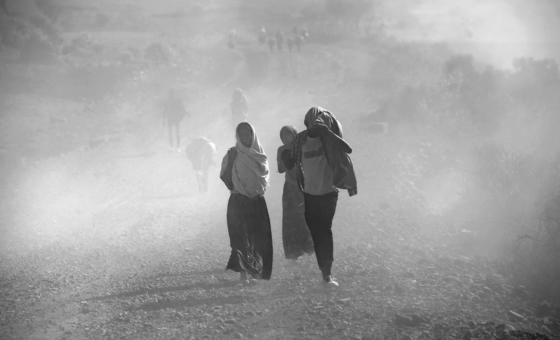Launching its annual sand and dust storm report the World Meteorological Organization (WMO) said poor environmental management had made their occurrence worse.
WMO Secretary-General Celeste Saulo called for increased vigilance due to climate change.
“Scientific evidence shows that human activities are having an impact on sand and dust storms,” she said.
She cited higher temperatures, drought and higher evaporation levels which lead to lower soil moisture – exacerbated if combined with poor land management.
Every year 2,000 million tons of dust enters the air, darkening skies and air quality in areas thousands of km away and impacting economies, ecosystems, weather and climate.
Hotspots
2023 saw slightly a slight drop in dust emissions globally but concentrations increased in Central Asia, northern and central China and southern Mongolia.
While dust storms are a problem on land, their long-range transport across the oceans is a bonus.
The WMO report shows that Saharan dust in the Atlantic Ocean has provided essential nutrients like iron and phosphorus. These nutrients trigger the growth of phytoplankton, the base of the marine food chain and the whole ecosystem, including economically important species like skipjack tuna.
It also states that March to May 2023 saw 13 big dust events in East Asia, with a major event in March that hit Mongolia and northern China, also reaching the Korean Peninsula and Japan.
A cyclone over Mongolia and cold winds caused visibility to drop to less than 500 metres in parts of Beijing.
In the Sahel and Gulf of Guinea, Harmattan winds brought persistent dust from autumn 2023 to winter, affecting air quality and visibility and the western Maghreb, Sahel and Gulf of Guinea in December.
UN assists around 600,000 in Mali in first quarter of 2024
The UN and humanitarian partners are continuing to support Malian Government-led aid efforts, reaching an estimated 600,000 people with much needed support during the first quarter of 2024.
“However, needs continue to rise, amid an influx of refugees and asylum seekers, mainly from Burkina Faso”, said UN Spokesperson Stéphane Dujarric, at the regular noon briefing on Friday in New York, adding that this also marks the beginning of the annual so-called lean season.
More than 1.3 million people in Mali are suffering from acute hunger under the IPC food classification index, with more than 2,500 of them facing catastrophic conditions – IPC Phase 5.
Government figures indicate 330,000 people in Mali are internally displaced as of the end of May and although overall displacement has decreased slightly since the start of the year, it is still rising in some areas, added Mr. Dujarric.
Insecurity rife
This includes areas impacted by insecurity in northern and eastern Mali, including in Bandiagara, Gao and Menaka, more than 80 per cent of them women and children.
“Our humanitarian colleagues stress that stepped-up funding for the humanitarian response in Mali is of course critical – as is an improvement in the security situation that will allow aid organizations to access and deliver assistance to people in hard-to-reach areas”, said the UN Spokesperson.
Six months into the year, the $700 million Humanitarian Response Plan for Mali is less than 19 per cent funded.
Ambitious UN project aims to connect every school to the Internet by 2030
And finally, around one-third of humanity lacks Internet access but this is all set to change thanks to a groundbreaking UN project to connect all schools to the web.
The Giga initiative aims to get every school in the world online by 2030. The partnership between UN digital technology agency ITU, and the UN Children’s Fund (UNICEF) already operates in 34 countries; this number is set to expand to 50.
Connectivity Forum
At the Giga Connectivity Forum in Geneva this week, ITU Secretary-General Doreen Bogdan-Martin said that the UN wanted “every young person to have a voice, a choice and an opportunity in today’s digital revolution”.
Schools that do not have Internet access are already being identified using satellite imagery, open-source technology and artificial intelligence (AI).
The Giga project then designs connectivity solutions for them, secures funding and works with authorities and private partners to build the infrastructure needed to get kids online.
So far, $6 billion has been raised to finance the initiative over the last three years.
To assist existing and new national members, the UN agencies ITU and UNICEF have set up the Geneva Global Connectivity Centre and Learning Hub – designed to share solutions and knowledge on Internet connectivity so that the ambitious 2030 goal can be reached.

